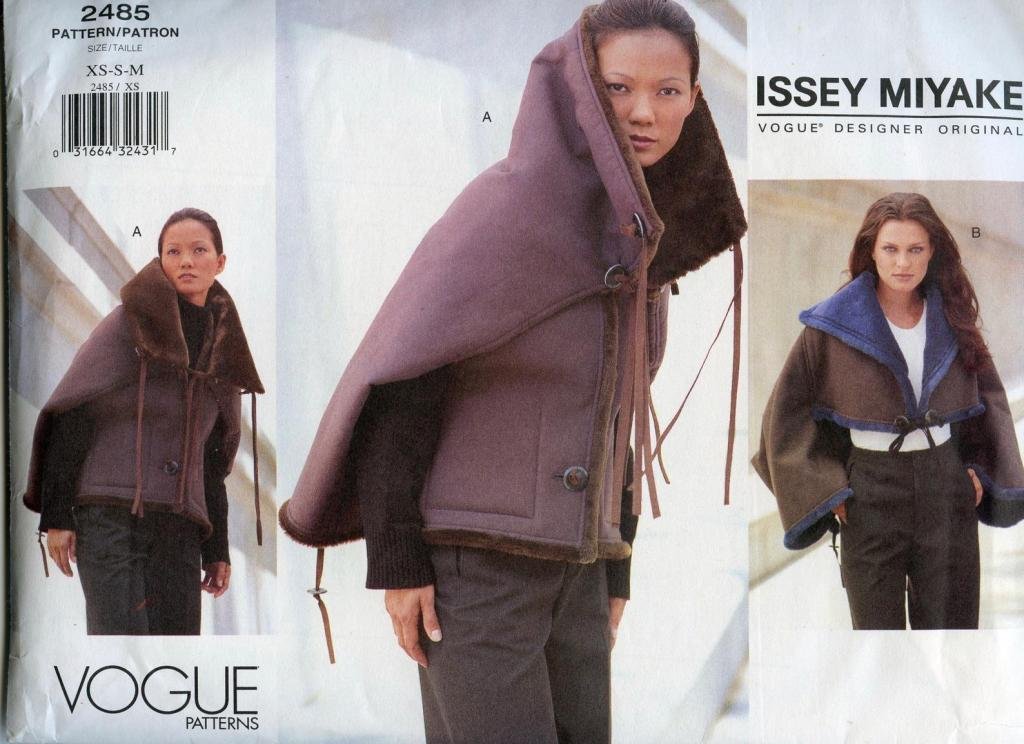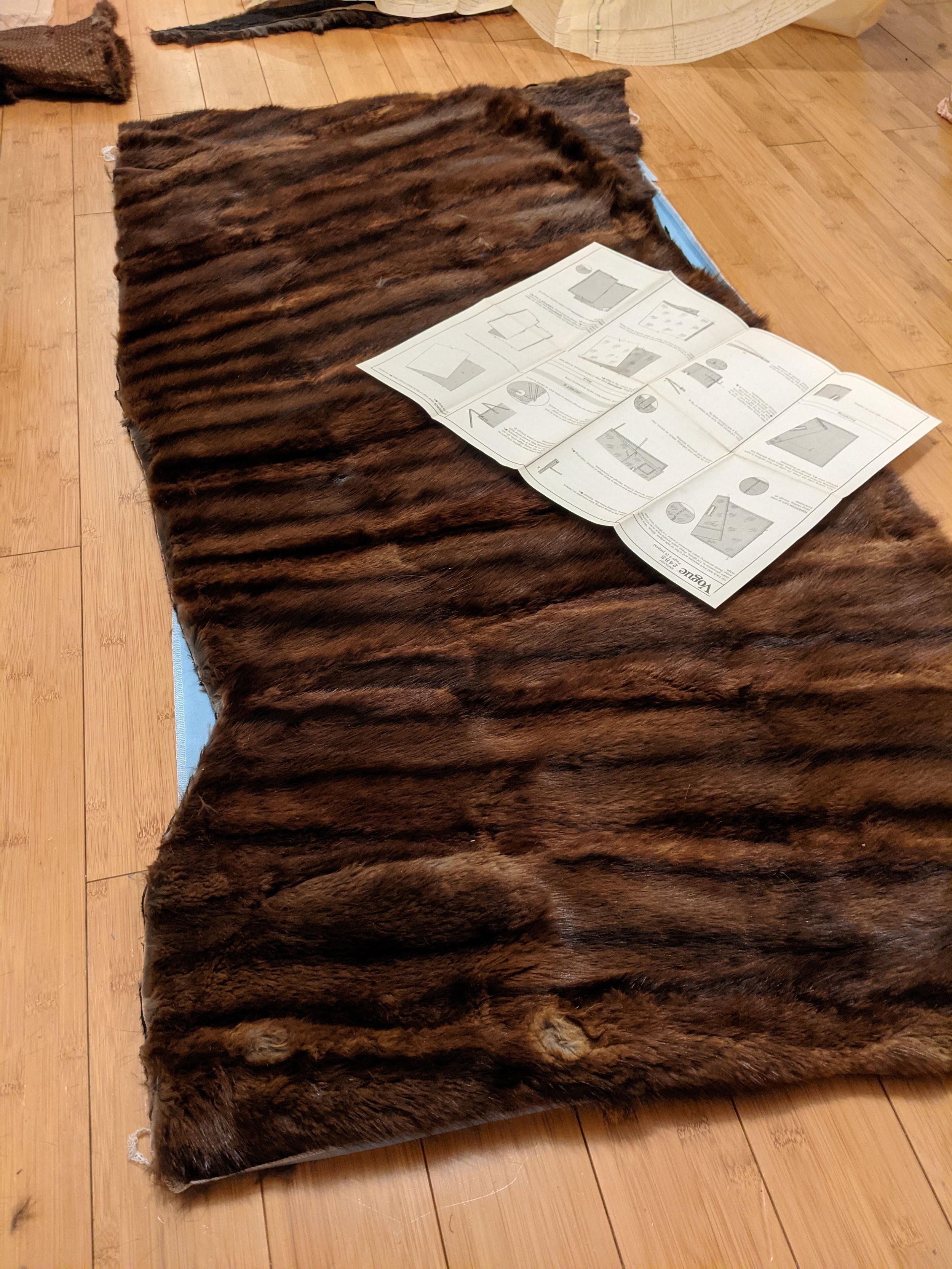Sewing Issey Miyake Pattern 2485
In the beginning of this year I started working on Vogue 2485, the Issey Miyake pattern I have wanted for probably half a year at least and which I received as a Christmas gift from my boyfriend. You can read my long digression on Miyake patterns in my previous Miyake post, Sewing Issey Miyake Pattern 2486.
This pattern recommends working with faux fur. I am not a fan of faux fur. It doesn't always have the correct weight that real fur has. I love the feel of genuine fur and I have since I was very young. I hate the look of scraggly, matted fake fur, which unfailingly reminds me of the Abercrombie and Fitch fake fur trimmed cropped puffer jacket that my best friend Holly wore in 7th grade, which I was both incredibly jealous of and disgusted by due to the long, wilted "fur" on the hood. Fake fur is made of a variety of plastics which as we know are derived from crude oils and are absolutely horrible for the earth. Real fur has rapidly fallen out of favor with the fashion world as many mega brands have vowed to no longer use fur, a list that includes Margiela, Prada, Gucci, and tons of other mid size brands. Personally, I think mass production from these so-called luxury brands shouldn't exist in the first place, never mind how many animals don't get skinned while they dump petrochemicals into the world's water supply, but that's a whole separate point. I believe that wearing and using real fur mindfully has its place in fashion. I used real fur.
I had to think for a while on how to source my fur. I wanted a low pile (short) fur, sometimes called "sheared," and many animals commonly used for their fur such as mink and beaver are quite small I wasn't sure how to obtain a large enough fur remnant for my project. Unlike hides, which commonly come from cows (and are an essential part of the beef industry that is part of using the entirety of the animal), one beaver pelt would not be enough for an entire garment. In preparation for this project, I purchased the book How to Sew Leather, Suede, Fur by Phyllis Schwebke and Margaret Krohn on eBay. Many forums that I checked had pretty minimal advice for working with animal hides, and leather working forums had little to say about clothing construction. So I ordered this book. Then I realized I could purchase what are called "scrap," "craft," or "cutter" furs off of eBay. These are terms sellers use to describe clothing or materials that are no longer wearing and only suitable for reworking. I found a seller called Oliver Furs based in Montreal. Oliver Furs is a professional fur wholesaler and furrier which uses 75% recycled or vintage furs and 25% farmed or First Nations trapped furs. Their fur selection was very beautiful and I purchased two very large muskrat fur coats that were labeled "scrap" for about $100 including shipping. I think anyone who has shopped fur in any capacity before would recognize how incredibly inexpensive this is especially considering shipping was about $60 from Canada. When I got the furs I was delighted by the high quality of the fur and how well preserved they were - to me they did not seem like scrap but if a fur business wanted to sell them as such I was happy to repurpose them! When I got my book and flipped to the Fur chapter, the first thing the authors recommended was to rework an existing fur into a new style. So I was happy to be on the right track with my project. I purchased a light blue cotton duck for the external part of the jacket because the pattern suggested broadcloth, canvas, or denim so I went with a similarly structured, heavy cotton.
Above left is the fur coat as I first started to work with it, right is the fur as it was initially attached to become the body and sleeves of the new coat.
I sewed View B of this pattern, which looked to me to be the simpler variation. View A has welt (AKA slashed) openings for the sleeve holes, and I didn't want to combine one of the techniques I find most challenging with my first time working with fur. I also find View B cuter. I have been very interested in mega cropped coats and jackets, like cropped at or above the bust, and this coat is super cropped in the front! It's described as "Very loose-fitting, below-hip (above-waist in front) and long sleeves."
This coat is actually made up of 3 rectangles, that's all. The largest rectangle which forms the back and the sleeves of the jacket is sewn together, canvas and fur, and then the sleeves are sewn by folding the rectangle hot dog style with the fur to the outside and connected along the outer 1/3 of each half. Confusingly worded but here is a photo of the body sewn:
The sleeves are made from partially sewing the large rectangle of the body, and the collar is to be attached to the upper raw edge.
The collar and front of the jacket are connected to the top of the sleeves body piece, and then connected to each other. Done! The coat is done.
The back of my coat and my silly gif showing the front and back of the coat.
The construction is deceptively simple. Disassembling the existing coats and then cutting the fur (which I did incorrectly because I just cut it all with scissors instead of the correct method of cutting only the hide with a razor blade to avoid trimming the hair) was challenging and messy. I worried the hide wasn't conditioned and would be too brittle but it was okay. The pattern calls for topstitching the fur to the canvas outer but I didn't see how I could press real (or fake!) fur without damaging it so I went off-pattern and sewed the fur and the outer fabric with right sides together and then turned the piece right sides out. The pattern pieces for the fur collar did not indicate a grainline (or a nap, in the case of fur direction) so I had to plan, then guess and hope I got it right so that the fur of the collar would lay consistently throughout the coat (luckily, it did). The pattern instructions were at times very vague and for such a non-intuitive construction it was very confusing, especially because you're not really supposed to unpick any stitching into hides because it will never heal like fabric fibers can and it weakens the skin overall.
But in the end it turned out really nicely. I love it and it keeps me very warm because of the fur and heavy canvas. I think the blue is very pretty and I love the contrast between the sky blue and the natural variegated dark fur. I'm glad to have given new life to a set of old unusable coats with a new project that I cherish. I enjoyed pushing myself and I love wearing this beautiful, unusual coat.





